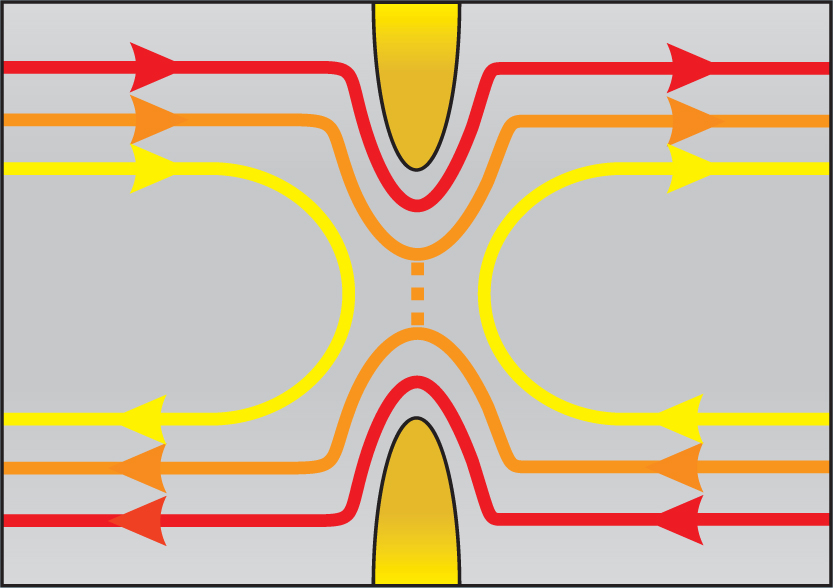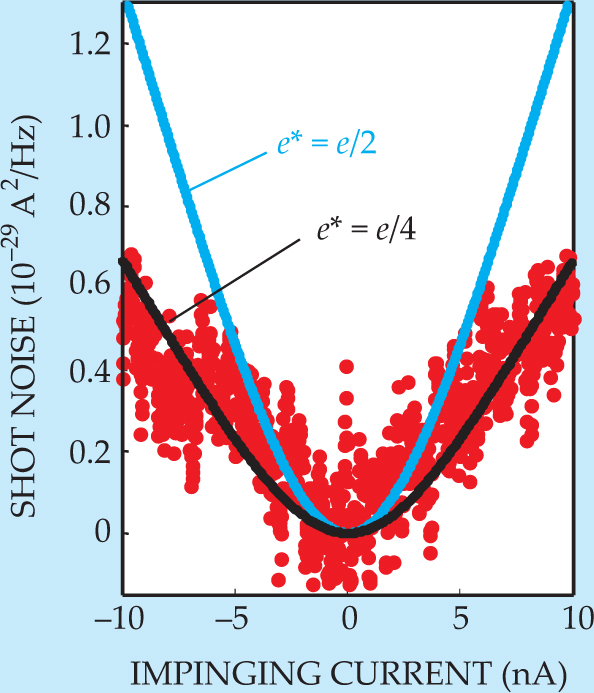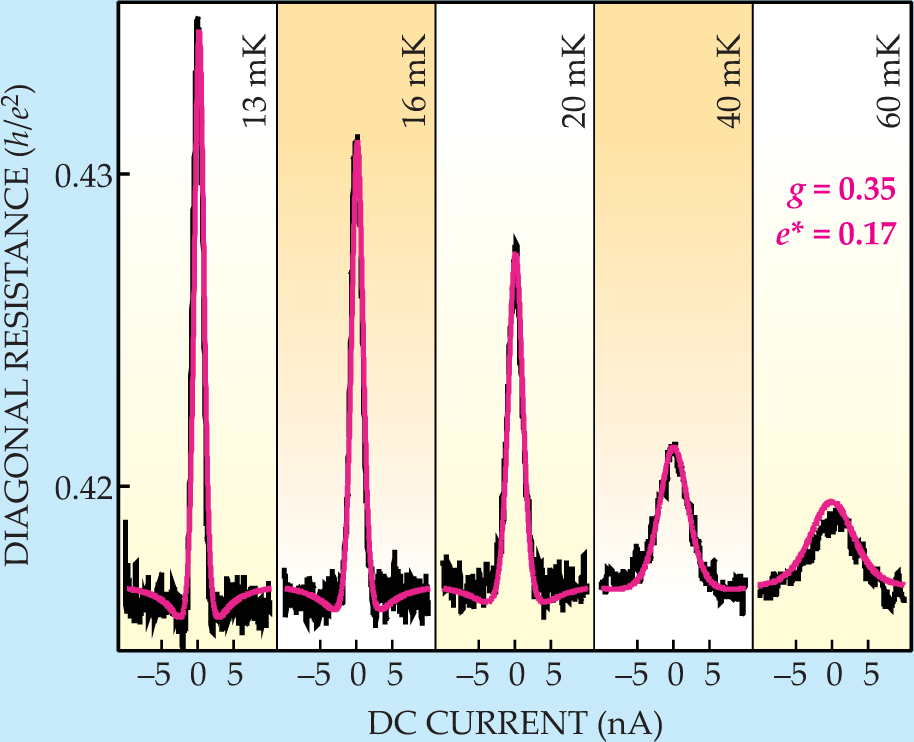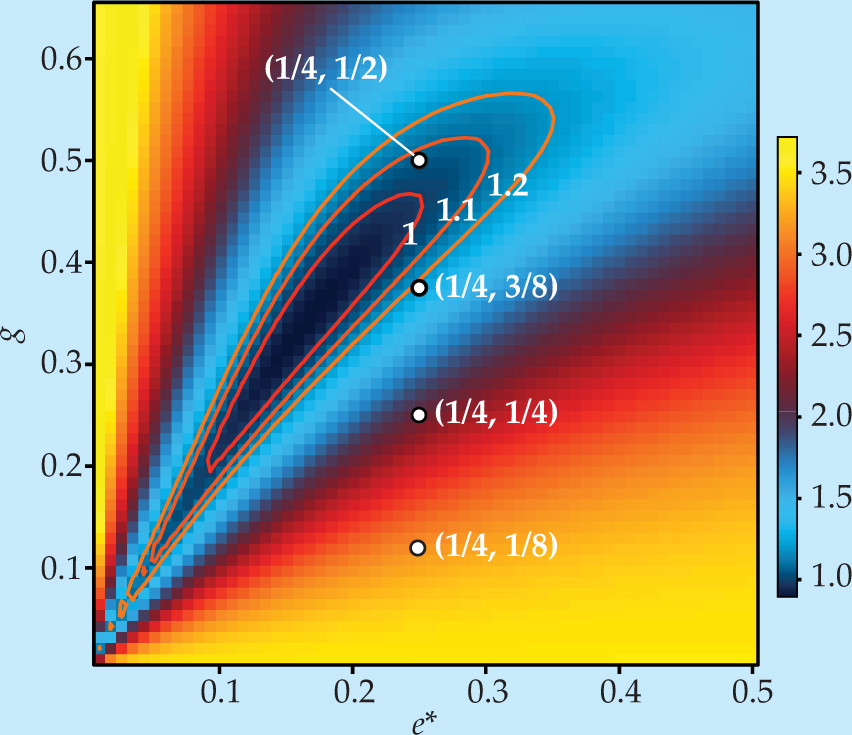Two groups measure the quasiparticle charge of the fractional quantum Hall state
DOI: 10.1063/1.2947634
The defining characteristic of the fractional quantum Hall effect is outwardly simple: At low enough temperatures and high enough magnetic fields, and in clean enough samples, the Hall conductance as a function of magnetic field features plateaus at exact rational fractions of
When Daniel Tsui, Horst Stormer, and Arthur Gossard first discovered the effect in 1981, all the fractions they found had odd denominators:
Then in 1986 Stormer’s graduate student Robert Willett discovered an even-denominator plateau at
Two years before Willett’s discovery, Bertrand Halperin had explored the possibility of even-denominator states. They’d be possible, he theorized, if the electrons paired up and changed their statistics to Bose–Einstein and their wavefunction to symmetric.
Even the odd-denominator states, which lack pairing, are complex. Long-range entanglement among the strongly interacting electrons yields a liquidlike state whose excitations behave like quasiparticles of fractional charge. Pairing increases the complexity further. A full and general description of the fractional quantum Hall state remains elusive.
As if to evince the gap in understanding, there are currently six candidate wavefunctions for the
Reassuringly for the candidates’ proponents, that value has now been confirmed by two groups of experimenters: one led by Mordechai Heiblum of the Weizmann Institute of Science in Rehovot, Israel; 1 the other led by Charles Marcus of Harvard University and Marc Kastner of MIT. 2
Both teams made use of tunneling between the edges of a Hall bar, but their experiments are different and complementary. The Weizmann researchers derived the quasiparticle charge
The value of
Finding a nonabelian state of matter would be a coup in its own right. The rich and subtle physics of such states would provide an arena where theoretical ideas from particle physics and condensed matter could be combined, extended, and tested.
There’s another reason for anticipated excitement. Swapping nonabelian particles doesn’t merely add a phase, as is the case for electrons, photons, or other abelian particles. Rather, a swap would transform one collective ground state into another via a unitary operation akin to flipping qubits. Because the operation involves the entire collective, it’s immune to the local perturbations that bedevil many other proposals for manipulating qubits. A nonabelian
Verifying the nonabelian nature of the
The fractions that characterize the conductance plateaus correspond to and have the same value as the filling factor
In the bar’s central bulk, the strong magnetic field traps conduction-band electrons in tight cyclotron orbits. Unable to move except in circles, the electrons can’t transport charge. The bulk is an insulator. At the bar’s edges, the electrons can’t complete their cyclotron orbits; they transport charge in counter-propagating edge states. And they do so as if split into fractionally charged quasiparticles.
Thanks to the Pauli exclusion principle, the quasiparticles flowing in the edge states keep apart like disciplined soldiers on a march. The resulting current is free of statistical, or shot, noise. If you could route the quasiparticles through a turnstile as they passed along the edges, the clicks would be rhythmic and regular.
Shot-noise measurements rely on simultaneously measuring fluctuations, which depend on the number of charged particles, and the current, which depends on the number of charged particles
But if edge currents are noiseless, how can one use shot noise to determine the quasiparticle charge? The answer is to pinch the edge currents together so that tunneling can take place between them. When a quasiparticle hops randomly across from one edge to the other, the gap it leaves behind in the orderly train of charge behaves like a source of shot noise.
Conceivably, one could bring the edge currents together by fashioning a Hall bar into an hourglass shape, but it’s more effective to do so electrostatically with a quantum point contact. The QPC consists of two sharp, closely spaced electrodes deposited on top of the Hall bar. Applying a strong negative voltage to the electrodes effectively clears away electrons from the region beneath the electrodes, effectively cutting the bar in two. Easing the voltage a bit creates a narrow isthmus, as shown in figure 1.

Figure 1. Conduction in the quantum Hall state takes place in counter-propagating edge states. Charging the electrodes of the quantum point contact (gold) pushes the edges together and spreads the current among more than one edge state. At a certain voltage, charge carriers in the lowest-lying edge state are too far apart to tunnel (red), while charge carriers in the highest-lying edge state are completely reflected (yellow). Tunneling occurs in the intermediate edge state (orange).
(Adapted from ref. 1.)

One consequence of using a QPC is that depleting the electrons at the isthmus changes the local density of electrons. If the applied magnetic field puts the bulk into, say, the
In Rehovot
Besides Heiblum, the Weizmann team consists of Heiblum’s graduate student Merav Dolev, who did the experiment; Vladimir Umansky, who made the highly pure heterostructure needed for the experiment; theorist Ady Stern; and Diana Mahalu, who patterned the device. Umansky’s role is noteworthy. Until now, from Willett’s 1986 discovery on, Bell Labs remained the world’s only source of heterostructures clean enough to sustain the fragile
For the task of identifying the edge states, Dolev made use of observations of how the transmission through the device varied with the total, longitudinal current. When the QPC is wide open and when the bulk is in, say, the
Narrowing the QPC starts to bring the lower-lying edge states,
Crucially, the current dependence disappears whenever the QPC is tuned to exclude tunneling—that is, to accommodate edge states that either pass through intact or are completely reflected. That case would correspond to a figure 1 without the orange, tunneling current. Measuring the Hall conductance at that point would identify the lowest-lying red current and, by implication, the next highest current.
Although the transmission dependence is not fully accounted for by theory, it is experimentally reproducible and qualitatively understood. Dolev used the dependence to tune the device and to make sure that the
Figure 2 shows the results of one run. The plot of noise versus current is consistent with a quasiparticle charge of

Figure 2. Shot noise in the
(Adapted from ref. 1.)

In Cambridge
The Harvard–MIT team consists of Marcus and Kastner, plus Marcus’s postdoc Jeffrey Miller and Kastner’s graduate student Iuliana Radu. Miller and Radu made the device and did the experiment. Loren Pfeiffer and Kenneth West of Bell Labs provided the heterostructure.
Like their Weizmann counterparts, Miller and Radu worried about which states were present in the QPC. By luck, they happened on a way of annealing their device to ensure that the edge states in the bulk and in the QPC were the same.
Miller and Radu would usually turn on the QPC gates after cooling the Hall bar to its few-millikelvin operating temperature. That sequence causes the electron density and therefore
To derive the quasiparticle charge and the exponent

Figure 3. Tunneling between edge states varies with temperature (black). The dependence, as fitted here with a model devised by MIT’s Xiao-Gang Wen (pink), allowed the team from Harvard University and MIT to extract the quasiparticle charge
(Adapted from ref. 2.)

Each of the candidate wavefunctions predicts a not necessarily unique pair of

Figure 4. Wavefunctions proposed to describe the
(Adapted from ref. 2.)

Verifying the nonabelian nature of the
“We all have the information,” says Marcus. “It would be perverse delayed gratification to do anything right now other than interference experiments.”
References
1. M. Dolev, M. Heiblum, V. Umansky, A. Stern, D. Mahalu, Nature 452, 829 (2008).https://doi.org/NATUAS
10.1038/nature06855 2. I. I. Radu, J. J. Miller, C. C. Marcus, M. M. Kastner, L. L. Pfeiffer, K. K. West,Science (in press).
